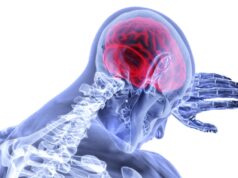
At the North American Neuromodulation Society (NANS) virtual meeting (15–16 January), Dylan J Edwards, director of the Moss Rehabilitation Research Institute and director of Human Motor Recovery Laboratory (Philadelphia, USA), presented his proof-of-concept results for a study he led looking at transcranial electrical stimulation (TES) paired with robotic assisted therapies in stroke recovery.
Edwards noted that TES can be used as a monotherapy, but he is interested in its use in combination with other therapies (speech, occupational, physical, robotics, drugs). In this case the combination is physical therapy using robot-assisted therapies.
Edwards stated this current research was motivated by a 2010 clinical trial published in the New England Journal of Medicine which compared robot assisted therapy with intensive comparison therapy, over 12 weeks and 36 sessions. The primary end point of this study was the Fugl-Meyer Assessment, and according to Edwards it showed a, “small but significant improvement in motor function that was sustained after the 12 week intervention”.
Edwards commented, “Robot therapy is not the only method of performing intensive physical-type therapy, however, it makes sense because the robot does not tire, and the therapy is really structured and consistent, and that’s important when you’re looking to apply a supplementary therapy so that you have a stable behavioural therapy upon which to test the supplement.”
Edwards reports he carried out a study in 2009 investigating transcranial stimulation in chronic post stroke hemiparesis in a small group of subjects. They showed that anodal transcranial direct current stimulation (tDCS) of 2mA for 20 minutes could raise the excitability of the corticospinal tract. Edwards said this made them question if they could embark on a period of robotic training for a session lasting 45 to 60 minutes after the tDCS session and what would happen to that potential. From this Edwards claims they showed that the increase in corticospinal excitement could be sustained during that robot therapy. So these therapies could plausibly co-exist physiologically.
The hypothesis of Edwards current trial is that robot therapy and tDCS would lead to a greater improvement than robot therapy with sham tDCS on the upper extremity Fugl-Meyer (UEFM) scale. They also assessed motor function using the Wolf motor function test. Eighty-two patients with right hemiparesis completed the trial. Each subject had three sessions of tDCS a week for 12 weeks. Sessions lasted one hour and were accompanied by alternating shoulder, elbow, and wrist robotic training amounting to around one thousand repetitions. The primary endpoint was 12 weeks and there was a six month follow-up.
The subjects were randomised between the real and the sham stimulation, although participants wore the same electrodes and were all tDCS naïve.
Edwards explained how they carried out robot therapies. Patients place their affected limb into the robot handle which has a display monitor in front of it. Then using the robotic device, patients aim to hit certain targets represented on the display. Edwards noted that this can be used as either an assessment or a training tool.
While Edwards was able to point to other studies which showed positive results for TES and robot-assisted therapy, such as Allman et al, 2016, and Giacobbe et al, 2013, he reported that in the case of his study, “The tDCS did not confirm an advantage over sham stimulation in this context.”
However, he added, “We haven’t ruled out a potentially faster recovery trajectory in the tDCS group, and the results for that could not be answered by the design of this study. But that does warrant further exploration given that the two other studies I presented did have a shorter number of sessions, by about a third of what we did. If tCDS could indeed lead to fewer sessions being required for the same clinical benefit, that warrants further investigation.”













